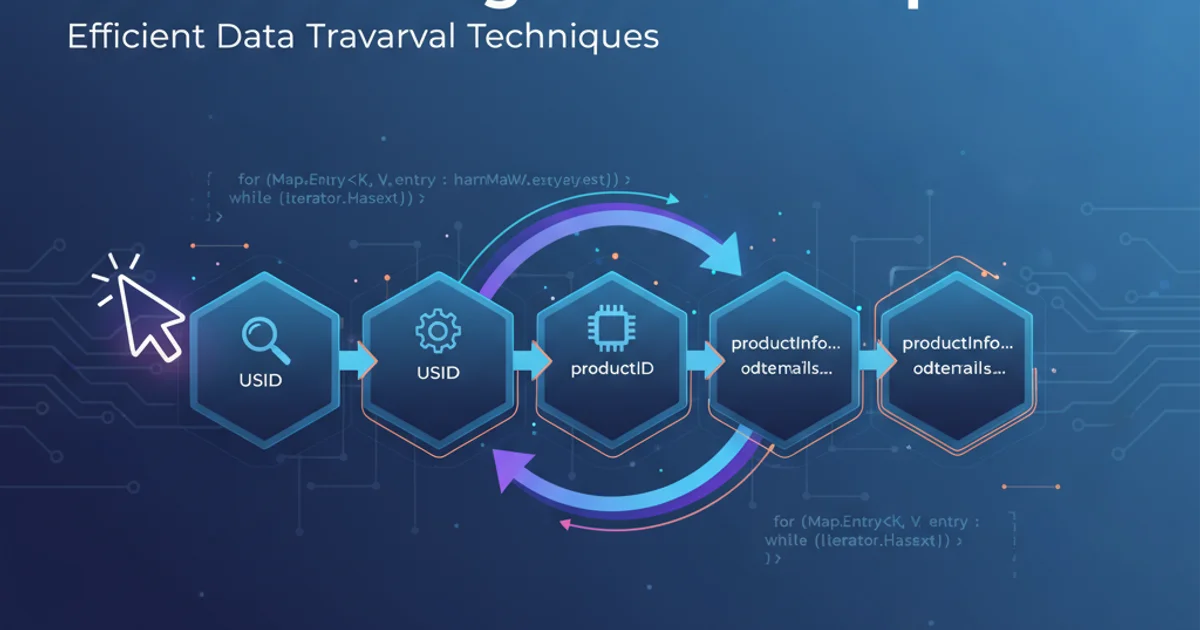Iterate through a HashMap
Categories:
Mastering HashMap Iteration in Java

Explore various efficient and common techniques for iterating through Java HashMaps, understanding their use cases and performance implications.
HashMaps are fundamental data structures in Java, providing efficient key-value storage. Iterating through a HashMap is a common task, but choosing the right method can impact performance and code readability. This article delves into the most popular and effective ways to traverse a HashMap, offering practical examples and insights into when to use each approach.
Understanding HashMap Structure for Iteration
Before diving into iteration methods, it's crucial to understand how a HashMap stores its data. A HashMap is an array of buckets, where each bucket can contain a linked list or a tree of entries. Each entry holds a key, a value, and a hash of the key. When you iterate, you're essentially traversing these entries. The order of iteration is generally not guaranteed and can vary across different Java versions or even between runs of the same program.
flowchart TD
A[Start Iteration] --> B{Get EntrySet/KeySet/Values}
B --> C{Iterator or For-Each Loop}
C --> D{Process Current Element}
D --> E{More Elements?}
E -- Yes --> C
E -- No --> F[End Iteration]General flow for iterating through a HashMap
Common Iteration Techniques
Java offers several ways to iterate over a HashMap, each with its own advantages. We'll cover the most frequently used methods: iterating over the entrySet(), keySet(), and values(), as well as using Java 8's forEach() method.
entrySet() is generally the most efficient method as it avoids redundant lookups.1. Iterating using entrySet() (Keys and Values)
The entrySet() method returns a Set view of the mappings contained in the map. Each element in this set is a Map.Entry object, which provides direct access to both the key and its corresponding value. This is often the most efficient way to iterate when you need both components.
import java.util.HashMap;
import java.util.Map;
public class HashMapIteration {
public static void main(String[] args) {
HashMap<String, Integer> ages = new HashMap<>();
ages.put("Alice", 30);
ages.put("Bob", 24);
ages.put("Charlie", 35);
// Using for-each loop on entrySet()
System.out.println("\nIterating using entrySet() with for-each:");
for (Map.Entry<String, Integer> entry : ages.entrySet()) {
System.out.println("Key: " + entry.getKey() + ", Value: " + entry.getValue());
}
// Using Iterator on entrySet()
System.out.println("\nIterating using entrySet() with Iterator:");
java.util.Iterator<Map.Entry<String, Integer>> iterator = ages.entrySet().iterator();
while (iterator.hasNext()) {
Map.Entry<String, Integer> entry = iterator.next();
System.out.println("Key: " + entry.getKey() + ", Value: " + entry.getValue());
}
}
}
Example of iterating a HashMap using entrySet() with both for-each and Iterator.
2. Iterating using keySet() (Keys Only)
If you only need to access the keys of the HashMap, you can use the keySet() method. This returns a Set view of the keys. To get the value associated with each key, you would then perform a get() operation on the HashMap, which can be less efficient than entrySet() if you need both key and value for every entry.
import java.util.HashMap;
import java.util.Set;
public class HashMapKeySetIteration {
public static void main(String[] args) {
HashMap<String, String> capitals = new HashMap<>();
capitals.put("USA", "Washington D.C.");
capitals.put("France", "Paris");
capitals.put("Japan", "Tokyo");
// Using for-each loop on keySet()
System.out.println("\nIterating using keySet() with for-each:");
for (String country : capitals.keySet()) {
System.out.println("Country: " + country + ", Capital: " + capitals.get(country));
}
// Using Iterator on keySet()
System.out.println("\nIterating using keySet() with Iterator:");
java.util.Iterator<String> iterator = capitals.keySet().iterator();
while (iterator.hasNext()) {
String country = iterator.next();
System.out.println("Country: " + country + ", Capital: " + capitals.get(country));
}
}
}
Example of iterating a HashMap using keySet() to access keys and then values.
3. Iterating using values() (Values Only)
When your task only requires processing the values stored in the HashMap, the values() method is the most direct approach. It returns a Collection view of the values. This method is suitable when the keys are not relevant to the operation.
import java.util.HashMap;
import java.util.Collection;
public class HashMapValuesIteration {
public static void main(String[] args) {
HashMap<String, Double> productPrices = new HashMap<>();
productPrices.put("Laptop", 1200.00);
productPrices.put("Mouse", 25.50);
productPrices.put("Keyboard", 75.00);
// Using for-each loop on values()
System.out.println("\nIterating using values() with for-each:");
for (Double price : productPrices.values()) {
System.out.println("Price: $" + price);
}
// Using Iterator on values()
System.out.println("\nIterating using values() with Iterator:");
java.util.Iterator<Double> iterator = productPrices.values().iterator();
while (iterator.hasNext()) {
Double price = iterator.next();
System.out.println("Price: $" + price);
}
}
}
Example of iterating a HashMap using values() to access only the values.
4. Iterating using Java 8 forEach()
Java 8 introduced the forEach() method for Map interfaces, which provides a concise and often more readable way to iterate. It accepts a BiConsumer functional interface, allowing you to define an action to be performed for each key-value pair.
import java.util.HashMap;
public class HashMapForEachIteration {
public static void main(String[] args) {
HashMap<String, String> userRoles = new HashMap<>();
userRoles.put("admin", "Administrator");
userRoles.put("guest", "Guest User");
userRoles.put("editor", "Content Editor");
System.out.println("\nIterating using Java 8 forEach():");
userRoles.forEach((key, value) -> {
System.out.println("User: " + key + ", Role: " + value);
});
}
}
Example of iterating a HashMap using the Java 8 forEach() method with a lambda expression.
forEach() method is generally preferred for its conciseness and readability, especially in modern Java development. It internally uses an Iterator but abstracts away the boilerplate.